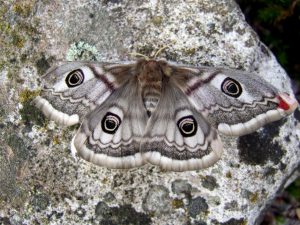 Garden tiger, peach blossom, beautiful golden Y, vapourer and Hebrew character are some of the names of the most fascinating group of insects namely moths. Despite the fact that there are over 800 types of larger moths we rarely see them as the majority are nocturnal. Whilst all the butterflies are seen in daylight taking nectar or egg laying, the moths take over at night. Whilst some of the moths, such as the ones listed above, are attractive, the majority are small and drab and we tend to overlook them. Some get their names from the markings on their wings and two of these can be found in readers’ gardens. One is the antler moth and the creamy markings on the wings really do look like miniature deer antlers. They have another interesting feature in that they fly both during the day and at night. The silver y moth gets its name from the tiny white mark on each of the forewings. This can be read as a Y or as the symbol for the Greek letter gamma (y). Like the antler moth they are unusual in flying both during the day and at night. However, what is even more fascinating about the silver Y is that, despite its sometimes very large numbers, it cannot survive our winters. This means it relies on immigrants from the continent every year which seems incredible as the moths are only about 40 mm across the wings.
Garden tiger, peach blossom, beautiful golden Y, vapourer and Hebrew character are some of the names of the most fascinating group of insects namely moths. Despite the fact that there are over 800 types of larger moths we rarely see them as the majority are nocturnal. Whilst all the butterflies are seen in daylight taking nectar or egg laying, the moths take over at night. Whilst some of the moths, such as the ones listed above, are attractive, the majority are small and drab and we tend to overlook them. Some get their names from the markings on their wings and two of these can be found in readers’ gardens. One is the antler moth and the creamy markings on the wings really do look like miniature deer antlers. They have another interesting feature in that they fly both during the day and at night. The silver y moth gets its name from the tiny white mark on each of the forewings. This can be read as a Y or as the symbol for the Greek letter gamma (y). Like the antler moth they are unusual in flying both during the day and at night. However, what is even more fascinating about the silver Y is that, despite its sometimes very large numbers, it cannot survive our winters. This means it relies on immigrants from the continent every year which seems incredible as the moths are only about 40 mm across the wings.
One of the most unusual of all the moths is the attractively named emperor moth that is an impressive 83 mm across the wings. The adults have false eyes on their wings and this acts as a defence mechanism in two ways. If a predator such as a bird or a mouse approaches and the moth flashes its wings in annoyance the predator may well be put off by the flashing eyes. If the predator persists it may think the eye on the wing is a vulnerable part of the moth, namely the eyes on the wings. This means that if only that part of the wing is taken the moth can still fly well so it is not a disaster. The other feature of the emperor moth that is even more amazing is that only the males fly by day whilst the females fly at night. If this was not unusual enough, the moths have their own special way of attracting each other. The female, see the photograph, sits in the heather on open moorland, which conveniently is the food plant of the caterpillars, and emits a strong smelling hormone. This attracts the male from some distance. In some circumstances you can actually see the male quartering the ground to find the receptive female.
Although some moths do not feed at all as adults, others will gorge themselves at night from nectars rich flowers such as honeysuckle. You can use this attraction to your advantage if you want to attract moths to get a closer look at them. It is called “sugaring” and involves mixing various items to attract the moths to feed. To make the moth mix take some brown sugar, molasses, a little red wine or beer and boil it up in a large pot. The end result is a sweet, sickly fluid and you paint this on trees or fence posts. At night use your torch to look at the sugar and the surrounding vegetation for any moths that are attracted. The first night may not be successful so try several nights application and then move to another site. Good hunting!
Tags: highland wildlife
